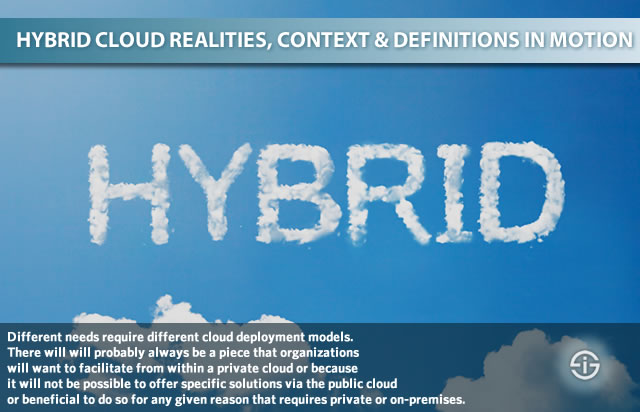Hybrid cloud is a hot topic in the overall evolutions of the cloud. Yet, ask ten people what the hybrid cloud model really means and you’ll get ten different hybrid cloud definitions. Moreover, vendors and providers of hybrid cloud solutions all have their own strategies and views with regards to their “offering”.
The latter is of course important if you need to compare hybrid cloud approaches and services from these several providers. One of the problems is that there are no real hybrid cloud computing standards, that there is quite some marketing speak which makes it more confusing and that the definition of hybrid cloud has been changing over time.
Whereas hybrid cloud computing used to stand for a coordinated way of using the resources from public cloud, private cloud and originally also the lesser known community cloud (which can take many shapes) in the best possible mix, views on hybrid cloud have expanded in some cases and even moved beyond the key cloud delivery models in others.
A hybrid cloud definition? It depends on whom you ask
The confusion that reigns with regards to hybrid showed when Forrester conducted a survey which we mentioned on our cloud computing page previously.
It indicated that IT decision makers define hybrid cloud in many different ways, ranging from “the use of public and private cloud” to “a cloud plus any additional cloud or non-cloud infrastructure”.
Strictly speaking, however, there is no hybrid cloud if it’s simply using a public and private cloud deployment or multiple cloud deployment services in an organization – or in other words having multiple forms of cloud as such.
A hybrid cloud requires orchestration between the public and private cloud platforms, interconnection, combination, communication, a degree of integration for combined usage and an orchestration layer.
The definition of hybrid cloud as “using a cloud in combination with non-cloud infrastructure” strictly speaking isn’t correct either. And hybrid cloud doesn’t mean the combination of some form of cloud with non-cloud on-premises or data centers, at least in the original scope of what hybrid cloud computing really meant.
The changing definitions of hybrid cloud
In a sense there should be little room for confusion about what hybrid cloud computing is and what it’s not.
The definition of hybrid cloud computing by NIST might be over a decade old but it’s still relevant to consider, even if most people nowadays find it too strict: in hybrid cloud several distinct cloud infrastructures are used which remain unique and serve various/different purposes but are tied by technologies that connect them and enable data and application portability, to rephraze the NIST definition of hybrid cloud a bit. The several distinct cloud infrastructures NIST refers to are private, public and/or community cloud.
However, not everyone agreed with this definition and hybrid got a broader meaning over time whereby the use of the term hybrid cloud was expanded to also include the combination of, for example, a public cloud in combination with more traditional IT infrastructure and on-premises. Others pointed to the fact that hybrid cloud didn’t have to mean public cloud in combination with a private cloud, for instance, but could also concern the combination of two public clouds.
If you call the combination of some form of cloud, often public, in combination with traditional IT (and we don’t necessarily mean private cloud here), hybrid cloud de facto is somewhat the definition for the cloud reality in most organizations as there are obviously connections between a public cloud and traditional IT resources, for example. That’s why it’s important to be careful with research on hybrid cloud computing. Depending on the source it originates from, the data on adoption could be entirely different as you might have discovered already.
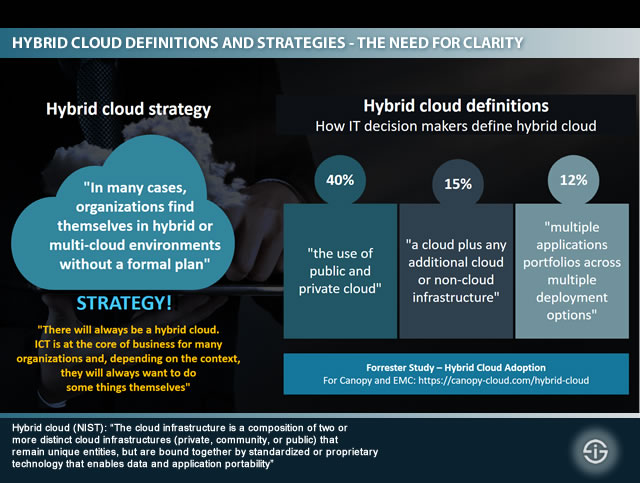
Gartner, for instance, stays close to the original definition of hybrid cloud computing: “Hybrid cloud computing refers to policy-based and coordinated service provisioning, use and management across a mixture of internal and external cloud services” (a list with more hybrid cloud definitions, including Gartner’s, below).
In the announcement of its hybrid cloud 2017 research, TechRepublic defined hybrid cloud as such: “Hybrid cloud is the combination of public cloud providers and private, on-premise hardware”. On-premises hardware isn’t cloud and if it’s on-premises and your organization alone uses it privately that’s not cloud either. Yet, further down the page the article says hybrid cloud is the combination of public cloud services with a private cloud infrastructure. That’s indeed something else than on-premises hardware.
From a hybrid cloud to a hybrid cloud environment
In a Forbes article, John Fruehe (Moor Insights & Strategy) points to the differences in hybrid cloud strategies from vendors and illustrates the evolution in thinking about hybrid and the broadening of the hybrid cloud definition by using the firewall as an illustration.
Originally hybrid cloud referred to one cloud, spanning the private cloud (one side of the firewall) and the public cloud on the other side of the firewall (outside the traditional firewall), Fruehe confirms. Today, however, we need to look more at it as a hybrid cloud environment he says and on the ‘private/enterprise’ side of the firewall such an environment also includes access to other resources than those in a private cloud.
It’s another way of looking at things. In the end, in a world where many started just started calling the data center a private cloud as well, it all doesn’t matter that much and we don’t want to get to academic about these hybrid cloud and hybrid cloud environment discussions nor about the fact that hybrid IT is not the same thing as hybrid cloud. It’s just important to know they exist.
In the end what matters most for organizations is not that much the definition of hybrid cloud, public cloud, private cloud and so forth.
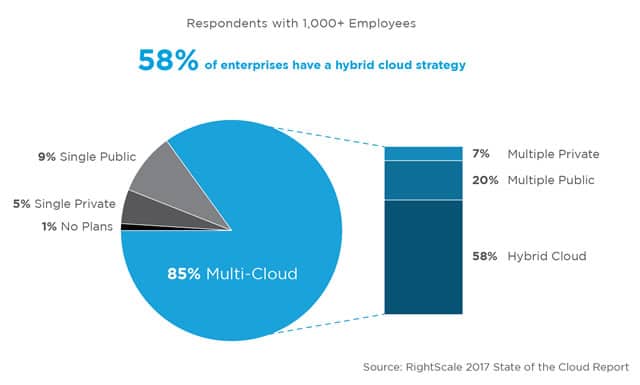
What is hybrid cloud really? Business first in the complexity of today’s IT infrastructure
What they care about is how to best manage their workloads and which types of solutions respond best to their needs and requirements, whether they are on-premises in a non-cloud environment, in a hybrid cloud environment, in one of the several forms of private cloud setup, in the public cloud or in any type of multi-cloud orchestration.
It’s about the capacities they need, the elasticity, the degree of availability, the ideal location for solutions such as backup in function of their context (whereby it doesn’t matter where it happens but how it happens best for the organization), the security, the management and manageability, etc. Or in other words: about the business.
We’ve called hybrid cloud the cloud model for an agile and real-time economy earlier when covering the strategic hybrid cloud roadmap of one of our partners, BT Global Services, and also pointed to hybrid cloud in a scope of hybrid multi-cloud environment.
From the hybrid cloud roadmap: “The hybrid cloud is neither a point solution nor a transitionary state toward a more unified model; on the contrary, a hybrid cloud is the optimal architecture for handling the inevitable complexity of a company’s IT infrastructure. It is a catalogue of cloud services that allows the business to select the right cloud service model delivery model for each application”.
And that complexity and reality includes the fact that in many organizations, even in many that don’t always know it, there is de facto often a multi-cloud environment to which a hybrid cloud strategy responds.
In the end, that was all about business too: the hybrid models for flexible business which are needed in digital transformation but also in the increasingly diversified IT reality where the role of IT and the CIO is changing with an overall shift in the benefits of cloud computing as a consequence, depending on the task, workload and application at hand in a bi-modal, tri-modal or multi-modal (whatever suits you best) IT model.
The business reality of hybrid cloud? There will will probably always be a piece that organizations will want to facilitate from within a private cloud or because it will not be possible to offer specific solutions via the public cloud – and that means hybrid cloud strategies will be needed for quite some time as there are many scenarios and reasons why private cloud will be used for many potential applications and part of the IT infrastructure.
Hybrid cloud definitions from others
If you want to add on-premises beyond private cloud to that: it’s all a matter of hybrid cloud definitions and standards.
More importantly it’s a matter of speaking the same language in a hybrid IT world.
A hybrid cloud roadmap for the hybrid IT paradigm of the real-time economy
In the real-time economy, the demand for cloud computing services keeps growing with the hybrid cloud as the optimal architecture for handling the inevitable complexity of the agile company’s IT infrastructure.
The real-time business requires a strategic cloud approach as the ongoing digitalization creates a new IT paradigm where all IT, logistics and production systems are connected into a real-time network infrastructure.
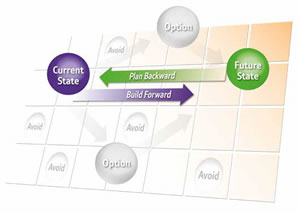
Research by Experton Group, commissioned by our partner BT Global Services, showed how the real-time economy is happening right now. Respondents realize that without additional investment into the enterprise IT and network infrastructure, higher agility towards the customers and a higher profitability cannot be achieved and executives realize that they will not be able to master the digital transformation towards the real-time economy with their current IT-infrastructure. From an IT perspective this brings us to a cloud model that incorporates flexible provisioning, on-demand service and resource pooling begins to make increasing sense, especially as higher agility is one of the key drivers in the growing interest regarding cloud services.
However, not all businesses are the same. There is no single cloud deployment model that is ideal for all business needs and that is where (a) hybrid cloud (infrastructure) comes in. Different needs simply require different cloud deployment models. In light of this complexity, companies should adopt a hybrid cloud architecture that allows for easy integration of distinct cloud infrastructures and services.
How do companies ensure that they adopt a strategic approach to cloud deployment and thus achieve maximum benefit from the latest cloud developments that are mainly driven by the consequences and needs of the real-time economy and at the same time enable it? In a whitepaper, embedded below, “Hybrid Cloud: A Strategic Roadmap” (embedded below), BT Global Services explains how and offers a hands-on roadmap to define a tailored strategy.
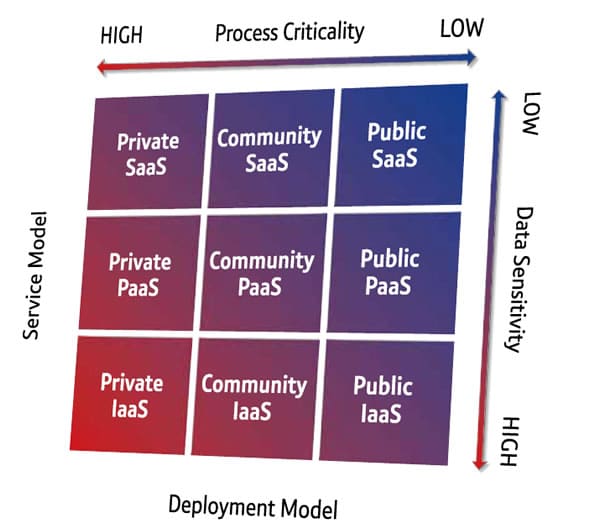
Below are some of the key cloud developments in the real-time economy as mentioned in the paper. You can also find them in the whitepaper, along with a hands-on roadmap to define your strategy.
The arrival of the real-time economy is one of the core drivers in the increased attention for hybrid cloud services.
A list of some aspects of cloud services that appeal more and more to business managers:
- Business agility: scale capabilities rapidly up and down in line with business need.
- Employee empowerment: real-time economy trends such as globalization, consumerization, BYOD and social (collaboration) technologies have a profound effect on what employees expect from corporate IT.
- Flexibility across business ecosystems: collaborating in projects across all possible boundaries is more important than ever in an agile work and even digital workplace context.
- Big data: while most large companies see the Big Data opportunity, most often in a real-time economy context, few actually benefit from it. An on-demand model makes increasinly sense in that regard.
Top image: Shutterstock – Copyright: phloxii – All other images are the property of their respective mentioned owners.


